|
Fighting Cancer with Your Fork
Cooking classes teach how to eat your way to health
Roxana Popescu | December 7, 2009
Jerry Bryant learned how to make low-fat banana bread in the spring of 2005, around the time he realized his wife, Donna, truly was dying.
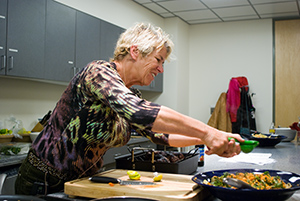
Susan Faerber, director of the Healing Foods Kitchen and the instructor at last week’s dinner class, prepared a sweet potato dish with a zing of lime juice.
The kidney cancer had spread to her lungs, an operation had not gone well, doctors were not optimistic, and a clinical trial she signed up for as a last effort did not appear to be working.
“It was a very difficult time for her,” Bryant said in a recent interview, his voice softening when he tried to articulate those words. One day, when they were coming or going from a trial medication session at the Moores UCSD Cancer Center, the couple noticed a table with people handing out aromatic samples in little plastic cups, Costco-style. It was some sort of chicken with a mix of vegetables and herbs, Bryant said, and it was delicious. The samples were advertising cooking classes at the center’s Healing Foods Kitchen, new that year.
Bryant and his wife immediately signed up. She attended three sessions, then grew too weak. So, Bryant did the cooking. He learned to make the low-fat banana bread, Moroccan stew and sweet potatoes and peanut sauce, and Texas two-bean chili.
His wife passed away the following spring.
Today, Bryant, is still attending the classes – now as a teaching assistant, showing new students how to cook healthy meals, helping with kitchen prep and answering questions. He is healthy, looks at least a decade younger than his 76 years, and he credits the nutritious foods he has been eating.
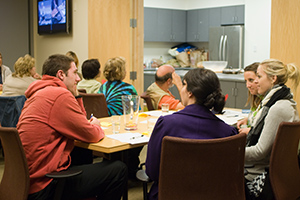
The classes, which convene seven times per month, are open to patients at the Moores Cancer Center, their friends and family, as well as people in the community at large who are curious about healthy eating. Preregistration is required.
Since 2005, patients at the Moores Cancer Center, their friends and family, and members of the community at large have been invited to the center’s cooking classes to learn how to eat to thrive. In a program organized by Susan Faerber, director of the Healing Foods Kitchen, and Vicky Newman, director of Nutrition Services for the UCSD Cancer Prevention and Control Program, instructors demonstrate healthy recipes seven times per month.
Faerber, whose energy comes across in the way she speaks as well as the bold and unusual combinations of flavors she devises, scoffs at food fads. “Pomegranates, blueberries, now acai berry? If you eat a wide variety of foods, you’ll get a wide variety of nutrients,” she said.
Her mantra: “Eat in colors.” Every day, count the colors that you’ve eaten, she says. “If you’ve eaten the rainbow, you’ve gotten the nutrients you need.”
At a class last week, Faerber greeted about 25 students and started her lesson. This month’s theme is “Celebrating with Big Color and Big Flavor,” and the menu reflected that. Selections included a cranberry dip, caramelized spiced carrots, bok choy salad, a persimmon fennel salad, roasted lamb, and persimmon lemon bars for dessert. As she cooked, Faerber wove in preparation strategies, like which blender to use, whether a dish was fit for being cooked ahead, whether it might work well for a dinner party or pot luck.
She also offered a steady stream of health tips.
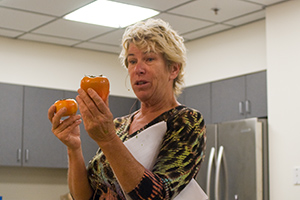
Faerber interlaces her instructions with a running commentary about the ingredients. Here she explains the difference between Fuyu and Hachiya.
“When you’re adding different spices, you have to think of them as medicine almost, because they have phytochemicals in them,” she told the class as she prepared a sauce. “Some people advocate eating turmeric every day for health and cancer prevention.”
The mood was casual. People asked questions – what’s the difference between the two kinds of persimmons she used? Could something be frozen and thawed? After the lesson, students ate what was prepared and traded ideas and reactions about the ingredients and how they might incorporate what they learned.
Kathy and Michael Lawrence have been coming every month since May. She recently finished radiation therapy for breast cancer, and she says the lessons have dramatically altered how she views food. Now, she cuts back on meat in recipes and has been feasting on a mix of greens and legumes.
“We’re hoping that increasing our vegetables will help lessen our chance of recurrence,” Kathy Lawrence said.
In an interview, Faerber explained the rationale behind the menus she creates: each lesson aims to mix ingredients most people are used to with a handful of less familiar ones – fennel, persimmons, bok choy. She also teaches students how to read labels, measure healthy portions and improve recipes they find outside class by substituting ingredients – like applesauce instead of fat, or a hearty vegetable instead of meat.
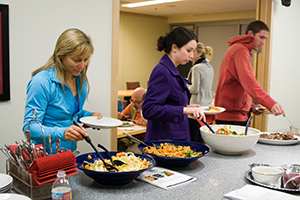
After the lesson, participants are invited to stay and eat the results, trade reactions about what they just learned and help with clean up.
The classes are free, menus and themes change frequently, and students typically include a mix of current cancer patients, friends and relatives, people who had recovered, and people interested in cancer prevention or healthy eating in general.
Materials and equipment, including a state-of-the-art kitchen with video cameras, are paid for by a combination of donations and funding strategies, including a cookbook called Food For Thought created for the course, a spring party and croquet fundraiser, and product sales during classes (sold at a marginal markup). An anonymous donor is matching up to $60,000 of funds raised.
Faerber said she believes eating well is something everyone can benefit, and that is why the cooking classes have been attracting people from all walks of life.
“We believe that foods nurture, and that it’s part of the whole healing process,” Faerber said.
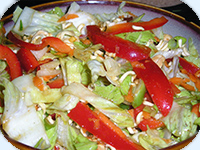
CRUNCHY BOK CHOY SALAD
Dressing:
2 Tbsp sugar
3 Tbsp cider vinegar or seasoned rice vinegar
3 Tbsp low-sodium soy sauce
1 Tbsp peanut butter
½ tsp curry powder (or to taste)
¼ tsp crushed red pepper (or 1/8 tsp cayenne)
Salad:
1 3-oz package ramen noodles, crumbled (discard seasoning packet)
¼ cup dry-roasted peanuts
3 cups bok choy (include stalks and greens), thinly sliced
1 cup red bell pepper cut in thin strips
½ cup shredded carrot
½ cup green onions, diagonally cut
Combine dressing ingredients in a large bowl, stirring with a whisk, and set aside.
Combine crumbled noodles, peanuts, bok choy, and the remaining ingredients in a large bowl.
Drizzle dressing over the salad, tossing gently to coat. Serve immediately.
Yield:
5 (1-cup) servings.
Each serving provides about 170 calories, 7 grams protein, 6 grams fat, 3 grams fiber, and 25 grams carbohydrate.
Count each serving as 1 ½ vegetable servings.
Makes 6 1-cup servings.
Each serving provides about 125 calories, 6 g protein, 1 g fat, 4 g fiber.
Count each serving as 1½ vegetable servings, 1/6 Fruit serving & 1/6 juice serving on your Weekly Food Checklist.

|